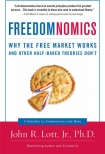Freedomnomics: Why the Free Market Works and Other Half-Baked Theories Don't John Jr. (the dot read aloud .txt) 📖

- Author: John Jr.
Book online «Freedomnomics: Why the Free Market Works and Other Half-Baked Theories Don't John Jr. (the dot read aloud .txt) 📖». Author John Jr.
Government attempts to supplant parents as the primary source of social values are not even limited to totalitarian countries. A particularly disturbing example is evident in the justification given for the creation of Sweden’s extensive nursery school system. Declaring that “School is the spearhead of Socialism,” Ingvar Carlsson, Sweden’s education minister from 1969 to 1973 (and later prime minister), insisted that removing children from the home through “pre-school training is essential ‘to eliminate the social heritage’” of undesirable, reactionary parental views.103 Swedish educational theorists even advocated tax and government employment policies that would “get both parents out of the home, so that children are forced out as well.”104
By abolishing the very concept of the family, totalitarian governments hope to create a government monopoly on the transmission of social values. Once this is achieved, the main avenue through which this monopoly spreads the regime’s values is through the education system. By instilling in young students the idea that the regime is legitimate and acts fairly, totalitarian governments seek to reduce potential opposition to their rule. They invest enormous resources in these endeavors for a very rational reason—evidence shows that government-provided schooling reduces political opposition and predisposes students to support the government when they get older.105
In totalitarian countries, the hiring and firing of educators is often based explicitly on political grounds. Reporting on the Soviet Union, one observer noted that, “promotions based on non-academic criteria tend to dilute the quality of senior academics, and such promotions are common. Many educational administrators are essentially Party bureaucrats moved into this line of work.”106 In Communist Czechoslovakia, school administrators were “instructed to gather information from selected Communist students in the Pioneer and Youth Union organizations to present ‘a view from below’” regarding the political reliability of teachers.107 Soviet teachers also had to deal with the presence of “informers in the class.”108
Apartheid-era South Africa placed a similar value on ideological education. Four separate school systems were established for whites, blacks, Asians, and coloreds. Segregated racially, teachers taught to students of their own race. Being a black teacher in a government school was a dangerous job. Perceived as complicit in perpetuating apartheid, black teachers were pariahs in their own communities and were sometimes killed by other blacks. Ironically, despite the prevailing ideology of white-supremacy, the government was forced to pay black teachers the highest premiums over what they would normally earn to compensate for the risks they faced and to try to ensure their political reliability.
Today, this kind of state indoctrination is commonly found in radical Muslim states. In Saudi Arabia and other fundamentalist Muslim countries, “Arab children are being taught that Jews are inherently not humans, that they are born from monkeys and pigs, that it is perfectly alright to kill them.”109 Routinely portraying the United States as a manifestation of Satan, the Saudi and Iranian regimes teach that Islam will inevitably rule the world and that all non-Muslims will perish.110
One would assume that even if state education is used for these malign purposes in totalitarian or highly authoritarian countries, surely this isn’t the case in the United States. However, while the degree of indoctrination in American schools never reached totalitarian levels, a brief history of the evolution of American public schooling reveals that public schools, in fact, did develop specifically as a method to inculcate values supported by the government.
As in many other countries, public education in the United States began at the instigation of churches. For a long time, schooling was openly religious. In the 1820s, in New York and in other states, legislators became concerned that many students were receiving the wrong type of education. It was not that children were going uneducated—in 1821, about 93 percent of New York’s school age youths were already attending private schools.111 As expressed in legislative debates, the fear was that students educated in private Catholic schools would learn the wrong values and end up becoming criminals. If Protestant schools could be made less expensive through government subsidies, the legislators reasoned, some Catholics would transfer their children there, thus saving them from a life of crime.112
The subsidies began as a kind of voucher system in which approved Protestant schools received a per pupil payment. However, this had an unintended consequence: the subsidized Protestant schools started competing against each other to attract Catholic students. To compete, they began teaching more of what Catholic parents and students wanted—reading, writing, and math—and less of what they didn’t want—Protestant religious training. Advocates of the subsidies found that the subsidized schools were no longer providing the religious training that justified the funding program in the first place.
In response, subsidies were limited to the approved Protestant school nearest to a student’s home. This reduced the incentive for the schools to compete against each other, and thus to limit their Protestant religious instruction. As government programs tend to do, over time the subsidy scheme grew until it began eliciting complaints that the subsidized schools were getting most of their money from the government while being protected from competition. With the Free Schools Act of 1867, the state simply took over the subsidized schools, which then became public institutions.113 This is the surprising, true origin of America’s public school system.
So what are these government values that are spread in the education system? In short, the government has a vested interest in teaching the young to believe that government policies can effectively solve problems. Public school teachers have a natural incentive to teach this axiom as well. Recall my personal story form this book’s introduction, in which I related how public university professors abhorred the prospect of tax cuts, which could result in reductions of their own university budgets. Public high school teachers face the same incentives. They have an abiding, personal interest in perpetuating the growth of government, which is the source of their own livelihood.114
Government spending on education is widely viewed as an indisputably positive endeavor. Rival political candidates regularly compete by trying to top each other’s promises





Comments (0)